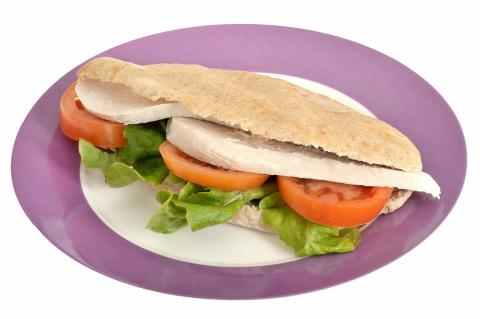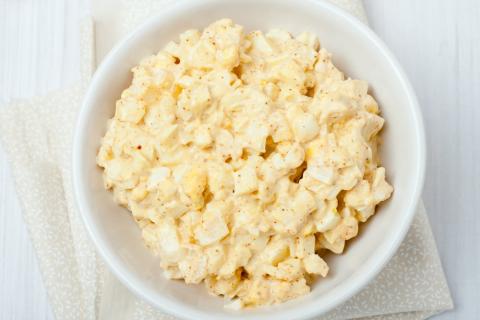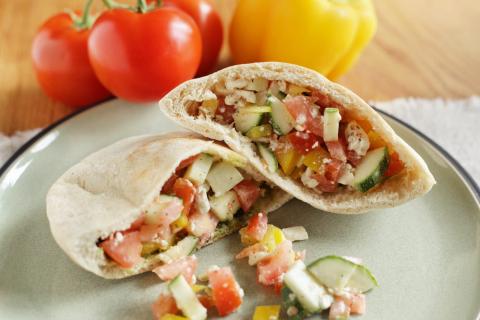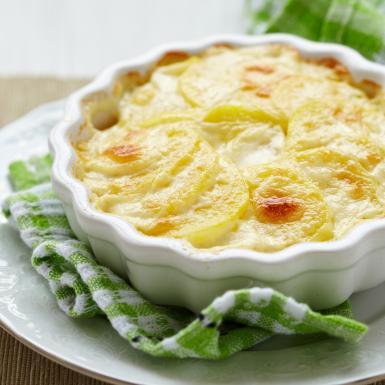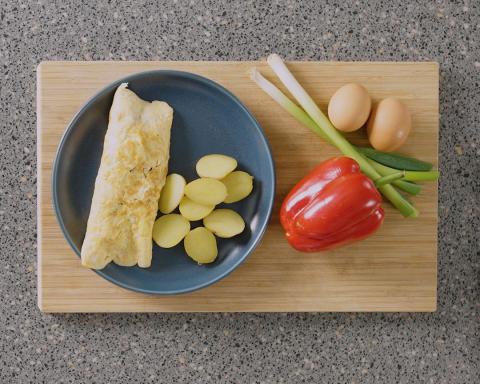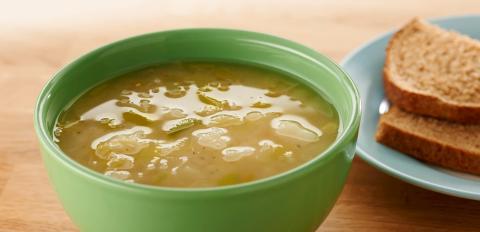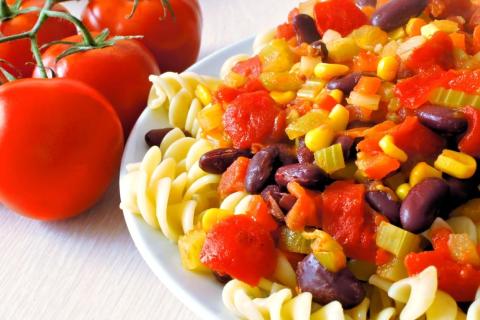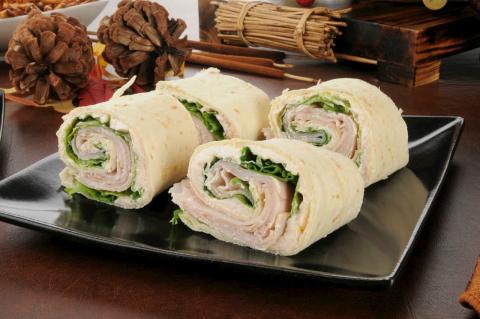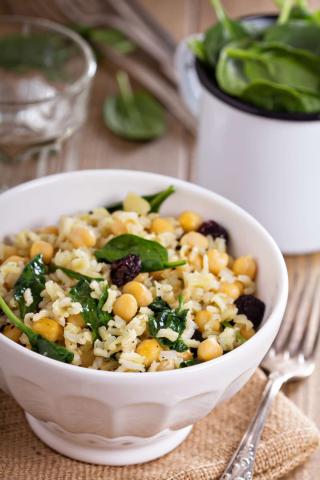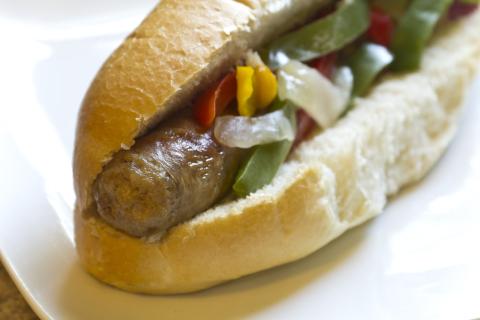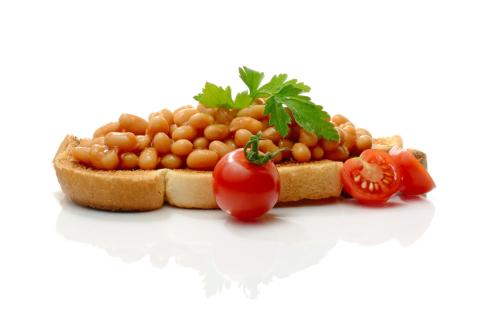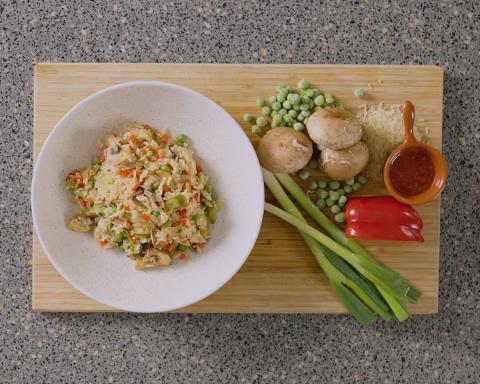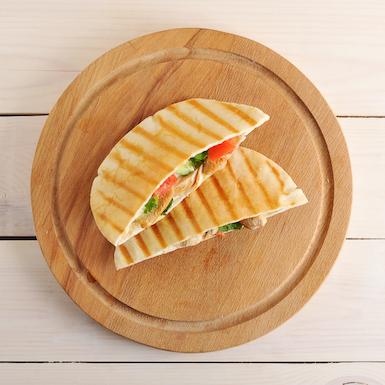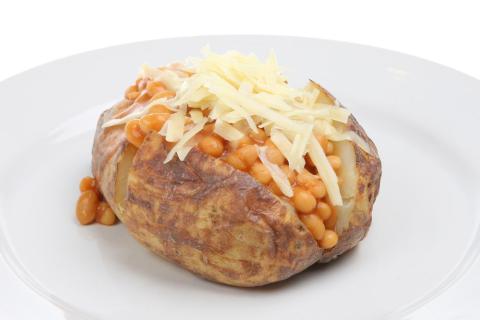- 10 Eggs
- 7 Medium Sized (600g) Potatoes
- 2 Medium Sized (300g) Onions
- 3 Teaspoons (15g) Low Fat Spread
- 1 Pinch (1g) Ground Black Pepper
Ingredients
Allergy Disclaimer
Always check the label of each ingredient for allergy warnings.
Method
- Peel and slice the onions. Wash and peel the potatoes and cut into roughly ½ cm slices.
- Heat 2 teaspoons of low fat spread in a large frying pan over a low heat. Add the onions and cook gently for 10-15 minutes until they start to brown.
- Meanwhile, add the potatoes to a saucepan, cover with boiling water and simmer for 8-10 minutes until just cooked through. Drain well.
- Break the eggs into a jug or bowl. Beat with a fork and add the pepper.
- Heat the grill. Add another teaspoon of low fat spread and the potatoes to the frying pan. Pour over the egg mixture and cook for 15 minutes until the omelette is nearly set and golden brown underneath.
- Put the frying pan under the grill with the handle outside the oven so it does not become too hot. Cook for a further 2 minutes, until the omelette is set and golden brown. Divide into four portions and serve.
Time Saver Tips
This recipe is ideal for using up any leftover cooked potatoes you have.
Cost Saver Tips
Save a bit of money by using any leftover potatoes and vegetables you have instead of buying fresh ones.
Tips for Kids
Choose your child’s favourite vegetables to add to the omelette.
Nutritional Information
Based on a single serving of 315g (% of an adult's reference intake)
Energy
339 kcals ( 17 %)
1,416 kJ ( 17 %)
Fat
4.4 g ( 22 %)
Saturates
26 g ( %)
Sugar
4.8 g ( 5 %)
Salt
0.5 g ( 9 %)
Detailed nutritional information
| Per 100g | Per 315g serving | |
|---|---|---|
| Energy Kcals | 107 | 339 |
| Energy Kj | 450 | 1,416 |
| Protein | 6.1 g | 19.4 g |
| Total Fat | g | g |
| Saturated Fat | 1.4 g | 4.4 g |
| Carbohydrates | 8.3 g | 26 g |
| Total Sugars | 1.5 g | 4.8 g |
| NSP Fibre | 0.9 g | 2.8 g |
| Sodium | 68 mg | 213 mg |
| Salt | 0.2 g | 0.5 g |
Find out about nutritional labelling
Nutrition labels on the front of packaging
- Most of the big supermarkets and many food manufacturers display nutritional information on the front of pre-packed food.
- Front of pack nutrition labels provide information on the number of grams of fat, saturated fat, sugars and salt and the amount of energy (in kJ and kcal) in a serving or portion of a recipe.
- The labels also include information about reference intakes (expressed as a percentage) which are guidelines about the approximate amount of particular nutrients and energy required for a healthy diet.
- The colour coding tells you at a glance if the food has high (red), medium (amber) or low (green) amounts of fat, saturated fat, sugars and salt.
- The more greens on the label, the healthier the choice
- Amber means neither high nor low, so you can eat foods with all or mostly ambers on the label most of the time.
- Reds on the label means the food is high in that nutrient and these are the foods we should cut down on. Try to eat these foods less often and in small amounts.
Food shopping tips
If you’re trying to decide which product to choose, check to see if there's a nutrition label on the front of the pack. This will help you to quickly assess how your choices stack up. You will often find a mixture of red, amber and green colour coding for the nutrients. So when you're choosing between similar products, try to go for more greens and ambers and fewer reds if you want to make a healthier choice.
 Activities & Play
Activities & Play Behaviour
Behaviour Childcare
Childcare Development & Growing Up
Development & Growing Up Family, Friends & Relationships
Family, Friends & Relationships Feeding Your Baby
Feeding Your Baby Food & Eating
Food & Eating Health & Safety
Health & Safety Mental Health & Wellbeing
Mental Health & Wellbeing Money & Work
Money & Work Online Behaviour & Safety
Online Behaviour & Safety Pregnancy & First Days
Pregnancy & First Days School & Education
School & Education Sleep
Sleep







